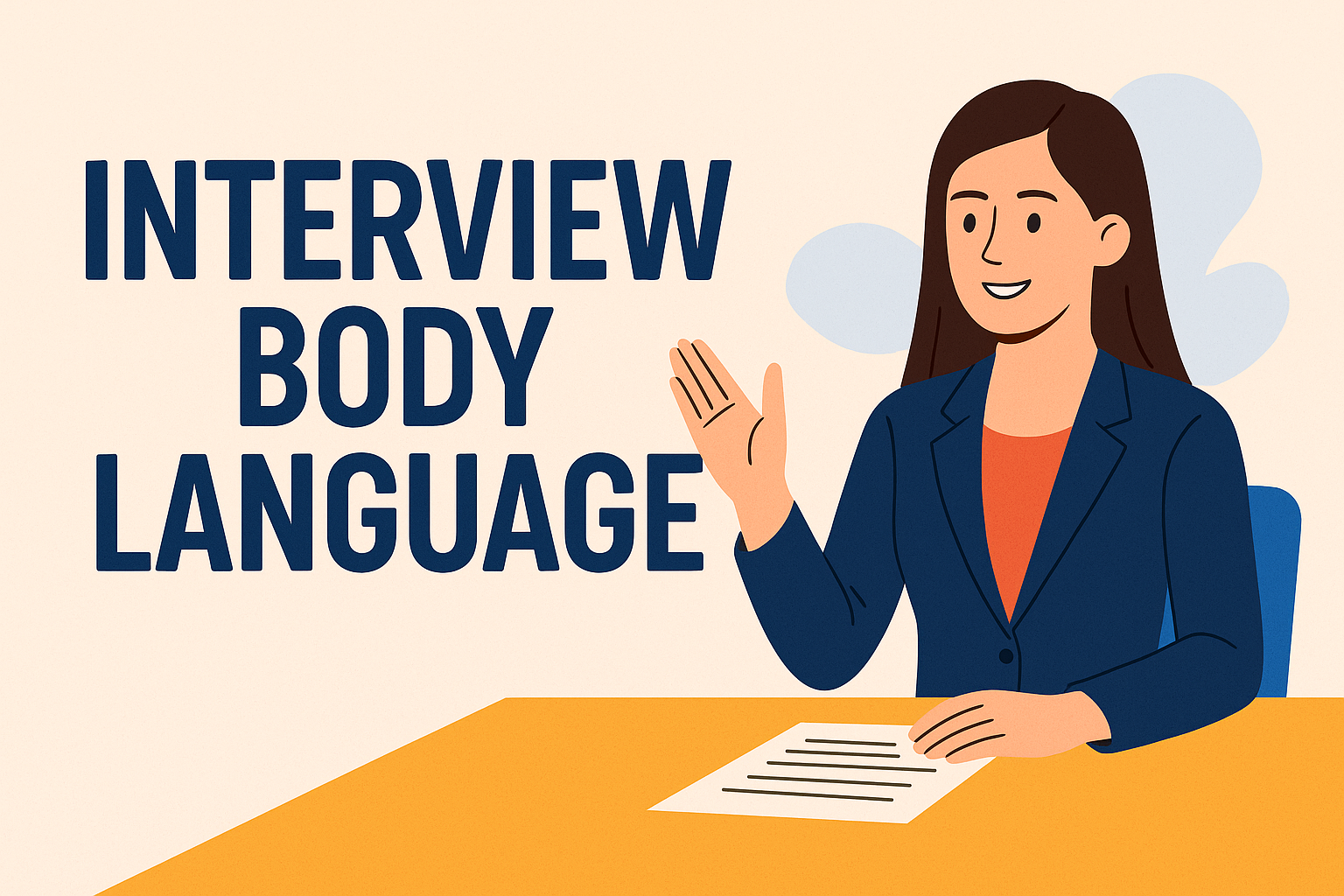Interview Body Language: What You Say Without Speaking

When it comes to job interviews, most candidates obsess over what to say. But few realize how much they’re saying without words. Your body language—posture, gestures, facial expressions, and eye contact—can be the difference between coming across as confident or nervous, enthusiastic or disinterested.
In fact, studies show that over 60% of communication is nonverbal. So if you want to make a strong impression, you need to nail your body language just as much as your answers.
In this blog, we’ll explore:
- Why body language matters in interviews
- Key do’s and don’ts for each stage of the interview
- Common body language mistakes and how to fix them
- Virtual interview body language tips
- A real-life case study
- Tools and exercises to practice nonverbal communication
Let’s make sure your body speaks success.
1. Why Body Language Matters in Interviews
Your interviewer is constantly picking up nonverbal cues. Whether they realize it or not, they’re using your body language to assess:
- Confidence and competence
- Openness and approachability
- Interest in the role and company
- Emotional intelligence
Poor body language can undermine great answers. For example, slouching or avoiding eye contact while talking about leadership will create doubt—even if your words are perfect.
Conversely, great posture, steady eye contact, and purposeful gestures can enhance even a modest resume.
2. First Impressions: The First 10 Seconds
Before you say a word, interviewers form opinions.
What they notice:
- Your posture when you enter the room (or appear on camera)
- Your handshake (if in person)
- Facial expression
- Eye contact
Tips:
- Stand tall, shoulders back
- Walk in with confidence and calmness
- Smile genuinely
- Maintain steady but respectful eye contact
- If virtual, look into the camera when greeting
3. During the Interview: Key Body Language to Practice
✅ Posture
- Sit upright but relaxed
- Don’t lean too far back or hunch forward
- Keep both feet on the floor if seated in person
✅ Facial Expressions
- Smile naturally when appropriate
- Show engagement (nodding, raising eyebrows slightly in interest)
- Avoid frowning or looking bored
✅ Eye Contact
- Hold eye contact about 60-70% of the time
- Don’t stare—break contact occasionally
- In virtual interviews, look at the camera, not the screen
✅ Hand Gestures
- Use open gestures to emphasize points
- Keep hands visible (not hidden under the table)
- Avoid excessive movements
✅ Head Movements
- Nod slightly to show understanding
- Tilt head occasionally to signal curiosity
Pro tip: Practice in front of a mirror or record yourself.
4. Common Body Language Mistakes and Fixes
❌ Fidgeting
- Playing with hair, pen, or jewelry
- Fix: Hold a pen lightly or rest hands on your lap
❌ Crossed Arms
- Can appear defensive or disinterested
- Fix: Keep arms open or rest hands on table
❌ Avoiding Eye Contact
- Signals discomfort or lack of confidence
- Fix: Practice eye contact with friends/family beforehand
❌ Slouching or Shrinking
- Makes you look unsure or disengaged
- Fix: Sit with a straight back and relaxed shoulders
❌ Over-gesturing
- Can be distracting or appear nervous
- Fix: Practice intentional gestures only when emphasizing a point
5. Body Language for Virtual Interviews
Remote interviews are here to stay. But virtual settings introduce new challenges.
Key areas to focus on:
✅ Framing & Lighting
- Your head and shoulders should be centered in the frame
- Face a light source for better visibility
✅ Camera Position
- Eye-level camera = eye-level contact
- Prop up laptop or use a webcam if needed
✅ Gestures & Expressions
- Use expressive facial gestures—small changes get lost on video
- Don’t stay too static—slight nodding and hand movement keeps energy up
✅ Stillness & Silence
- Avoid looking at yourself
- Don’t multitask or check your phone
- Stay attentive even when not speaking
✅ Bonus Tip: Nod while listening to show engagement.
6. Advanced Nonverbal Communication: Mirroring and Voice Tone
Mirroring
- Subtly mimicking your interviewer’s posture or tone creates rapport
- Don’t overdo it—keep it natural
Voice Tone and Pace
- Speak clearly and confidently
- Vary your pitch and avoid a monotone
- Pause after key points for emphasis
Practice Tip:
- Record yourself answering a question and analyze:
- Do you sound confident?
- Are you smiling?
- Do you pause or use filler words?
7. Case Study: Maria’s Nonverbal Transformation
Background: Maria, a marketing analyst from the UK, had strong credentials but kept getting rejected after final interviews. A mentor suggested reviewing her nonverbal communication.
What she discovered:
- She often looked down when thinking
- Spoke quickly without pausing
- Rarely smiled during interviews
Her action plan:
- Practiced with video recordings
- Paused and breathed between answers
- Held eye contact during intro and close
- Smiled when talking about work she loved
Result: Maria re-interviewed for a similar role three weeks later—and landed it. The hiring manager specifically mentioned how confident and energized she came across.
Takeaway: Body language isn’t fluff—it influences how your skills are perceived.
8. Practice Exercises to Improve Interview Body Language
A. Mirror Exercise
- Practice answering “Tell me about yourself” while watching facial expressions
B. Video Recording
- Record 3 answers and critique posture, energy, and expression
C. Mock Interview With a Friend
- Ask for feedback specifically on nonverbal communication
D. Warm-Up Routine Before Interviews
- Power pose for 2 minutes (arms raised or on hips)
- Deep breathing to regulate nerves
- Smile to release tension
Resources:
- Amy Cuddy TED Talk: “Your Body Language May Shape Who You Are”
- Interview Warmup by Google
- Big Interview Practice Tool
9. What Interviewers Are Really Looking For in Nonverbal Cues
✔️ Confidence (Posture, Eye Contact, Tone)
✔️ Engagement (Nodding, Expressions, Leaning In)
✔️ Authenticity (Relaxed Movements, Real Smiles)
✔️ Presence (No distractions or fidgeting)
✔️ Professionalism (Stillness, Clean Backgrounds, Attentiveness)
10. Final Thoughts: Speak With More Than Words
Your resume gets you in the room. Your words get you through the interview. But your body language seals the deal.
In a competitive job market, nonverbal communication is a secret edge.
When your posture, eye contact, and energy all align with your words—you create a powerful impression that hiring managers remember.
So don’t just prepare your answers. Prepare your presence.
More from UJ+:
- The STAR Method: Ace Every Behavioral Interview Question
- Top 10 Interview Questions and How to Answer Them With Confidence
Subscribe to UJ+ for weekly career prep tips, interview training tools, and expert insights.

